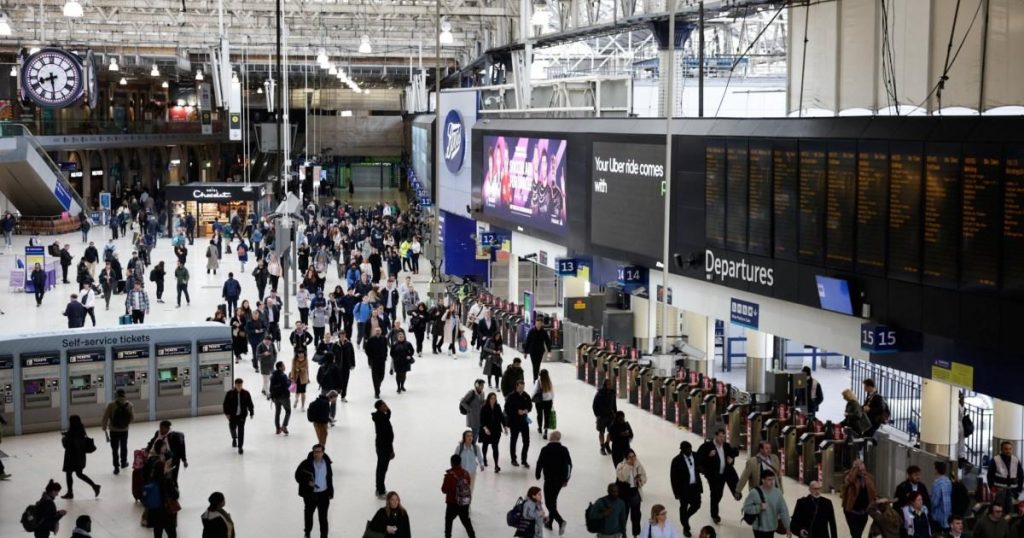Incident at London Waterloo Station Causes Disruption
On a seemingly ordinary morning, a disruption unfolded at London Waterloo, the UK’s fourth-largest railway station, causing inconvenience and delays for numerous rail passengers. The incident began with reports of a suspected fire, leading to the evacuation of four platforms – platforms 20 to 24. This immediate action impacted South Western Railway trains operating both into and out of the capital, with Clapham Junction serving as a key transit point affected by the closures.
The London Fire Brigade promptly responded to the situation, arriving at the scene around 9:30 am after receiving reports of a smell of smoke. Fire crews diligently investigated the area to determine the source of the smell and ascertain the presence of an actual fire. Their thorough assessment ultimately revealed that there was no fire present at the station. Following their investigation, the fire brigade determined the cause of the alarm to be dust emanating from a fan heater. With the situation deemed safe, the fire brigade departed the scene.
The initial suspicion of a fire and the subsequent evacuation caused significant disruption to train services. Passengers experienced delays and cancellations as the railway operators worked to restore normal operations. The incident served as a reminder of the potential for disruption in busy transportation hubs and the importance of swift responses to ensure passenger safety.
The Impact on Commuters and Train Services
The unexpected evacuation and platform closures at London Waterloo had a ripple effect on commuters and train services. Passengers experienced delays and cancellations, impacting their travel plans and daily routines. The incident highlighted the vulnerability of transportation networks to unforeseen events and the potential for such events to disrupt the flow of people and goods.
The rapid response of the London Fire Brigade played a crucial role in ensuring the safety of passengers and staff at the station. Their swift arrival and thorough investigation allowed for the prompt determination that there was no fire, minimizing the duration of the disruption. The incident underscored the importance of maintaining a state of preparedness and having effective emergency response protocols in place.
Lessons Learned and Future Preparedness
The incident at London Waterloo provided valuable lessons in emergency preparedness and response. The swift actions of the fire brigade demonstrated the importance of having well-trained personnel and effective communication systems in place to handle unexpected situations. The incident also highlighted the need for ongoing maintenance and inspection of equipment, such as fan heaters, to prevent similar occurrences in the future.
The disruption caused by the incident emphasized the importance of having contingency plans in place to manage disruptions to transportation networks. This includes having alternative transportation options available and providing timely information to passengers about delays and cancellations. The incident also underscored the need for continuous improvement in safety protocols and infrastructure to minimize risks and enhance the overall resilience of transportation systems.
The Importance of Clear Communication and Information Dissemination
During the incident, clear and timely communication played a crucial role in managing the situation and minimizing passenger anxiety. The London Fire Brigade and railway authorities provided regular updates to the public through various channels, including social media and news outlets, keeping passengers informed about the situation and the expected duration of the disruption.
Effective communication is essential in managing emergencies and ensuring public safety. Providing accurate and up-to-date information helps to prevent the spread of misinformation and allows passengers to make informed decisions about their travel plans. The incident at London Waterloo highlighted the importance of having robust communication systems in place to manage emergencies effectively.
The Role of Technology in Emergency Response
The incident also demonstrated the role of technology in enhancing emergency response capabilities. The use of sophisticated monitoring systems and communication tools enabled the fire brigade to respond quickly and efficiently to the reported incident. The availability of real-time information allowed for better coordination among emergency services and facilitated the dissemination of timely updates to the public.
Technological advancements continue to play an increasingly important role in enhancing emergency preparedness and response. From early detection systems to advanced communication networks, technology enables faster response times, better coordination among agencies, and improved information sharing with the public. The incident at London Waterloo underscored the need for continued investment in technology to enhance emergency response capabilities and improve public safety.




